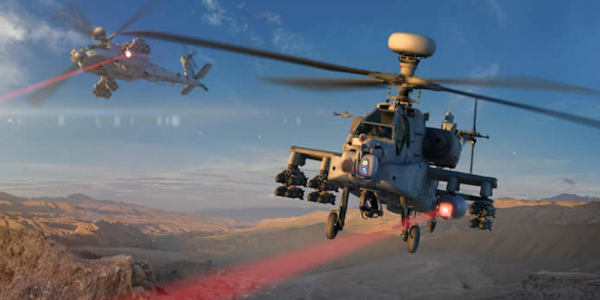

What’s cooler than sharks with frickin’ laser beams attached to their heads? AH-64 Apache attack helicopters with frickin’ laser beams attached to their heads.
In a joint experiment conducted by the Army, U.S. Special Operations Command, and defense contractor Raytheon, an Apache helicopter outfitted with a high-intensity directed energy laser successfully blasted an unmanned target out of the sky from 1.4 km (less than a mile) away, Raytheon announced on June 26.
The test, carried out at the White Sands Missile Range test ground in New Mexico, marks the first instance of a laser weapons system successfully eliminating a target from a rotary-wing aircraft “over a wide variety of flight regimes, altitudes, and airspeeds, proving the feasibility of laser attack from Apache.”
Raytheon has been working with the Army’s Apache Program Management Office on the Apache integration since at least May 2016. Speaking at an industry conference then, SOCOM Rotary Wing program chief Col. John Vannoy characterized the directed energy weapons initiative as a relatively inexpensive alternative to guided missiles and other munitions, a program that fits with Air Force Special Operations Command’s plans to outfit an AC-130J Ghostrider with an integrated laser system.
“We’re not at the point where we’ve laid out a business case to advance it,” Col. Vannoy said of aircraft-integrated laser systems. “We really want to understand the environment on the wing, the beam quality we can get off the wing and the ability to beam steer and keep power on a target.” Why the Army and SOCOM went with the Apache for such testing is unclear, especially given that, as Popular Mechanics points out, the command doesn’t typically utilize Apaches.
Related: The Air Force Is Preparing To Test A Laser Cannon On Its ‘Ultimate Battle Plane’ »
For special operations forces’ needs, slapping a bunch of laser cannons on an attack copter may prove more instructive than raining down an energy beam from a fixed-wing gunship high above the battlefield. The rotary-wing aircraft typically employed by SOCOM tend to engage targets within close range, cutting down on the factors — required energy, atmospheric dispersion, and the interference of dust and sand that can wreak havoc on laser-guided munitions — that could render a laser weapon ineffective.
More importantly, a rotary-mounted laser may prove more surgical and precise than the Apache’s typical armament of Hellfire missiles and 30mm cannons, especially for SOCOM operations that involve specific targets rather than unleashing all-out carnage on a battlefield. Even precision-guided munitions “still use high-explosives to make a big bang,” as The War Zone put it following Vannoy’s remarks in 2016. “If you want to be extremely precise with almost no chance of collateral damage, lasers are the way to go.”
Of course, the news of the successful Apache test comes amid an outbreak of laser fever in the halls of the Pentagon. In a DoD press release published the same day as Raytheon’s announcement, High Energy Laser Controls and Integration Directorate chief Matthew Ketner touted increasing efforts to incorporate fully-integrated laser systems into Army and Navy vehicles.
Related: The Army’s New Modified Stryker Has A Special Laser Surprise For ISIS »
But while the SOCOM Apache project was clearly designed with offensive applications in mind, the two branches have mainly explored defensive applications of solid-state lasers. In 2014, the Navy outfitted the USS Ponce with a 30-kilowatt cannon to counter UAVs and small vessels with the long-term objective of defeating anti-ship cruise missiles and ballistic missiles downrange (the branch plans on developing 100 to 150-kilowatt prototypes for at-sea testing as early as 2018). Even the Missile Defense Agency wants drone-mounted lasers to bring down ICBMs.
The Army’s laser projects are a bit more intriguing, but not by much. In April, the branch unveiled a specially modified Stryker prototype dubbed the Mobile High Energy Laser (MEHEL) at the Maneuver Fires Integrated Experiment at Fort Sill, Oklahoma, zapping dozens of remote-controlled targets out of the sky with a mounted 5 kilowatt laser cannon. But even though the MEHEL offers an elegant, automated countermeasure to the disturbing rise of ISIS suicide drones, don’t expect to see them liquify enemy fighters any time soon.
Sure, the prospect of lasers downrange is titillating in a science-fiction fanboy sense, but past defensive tests by the Army and Navy have proven a bit droll. With Raytheon’s successful test comes a glimpse at what the future of offensive directed energy weapons could potentially look like — and knowing that those weapons are in the hands of the elite warfighters of SOCOM is the most excited we’ve felt about DoD laser research in years.
WATCH NEXT:
